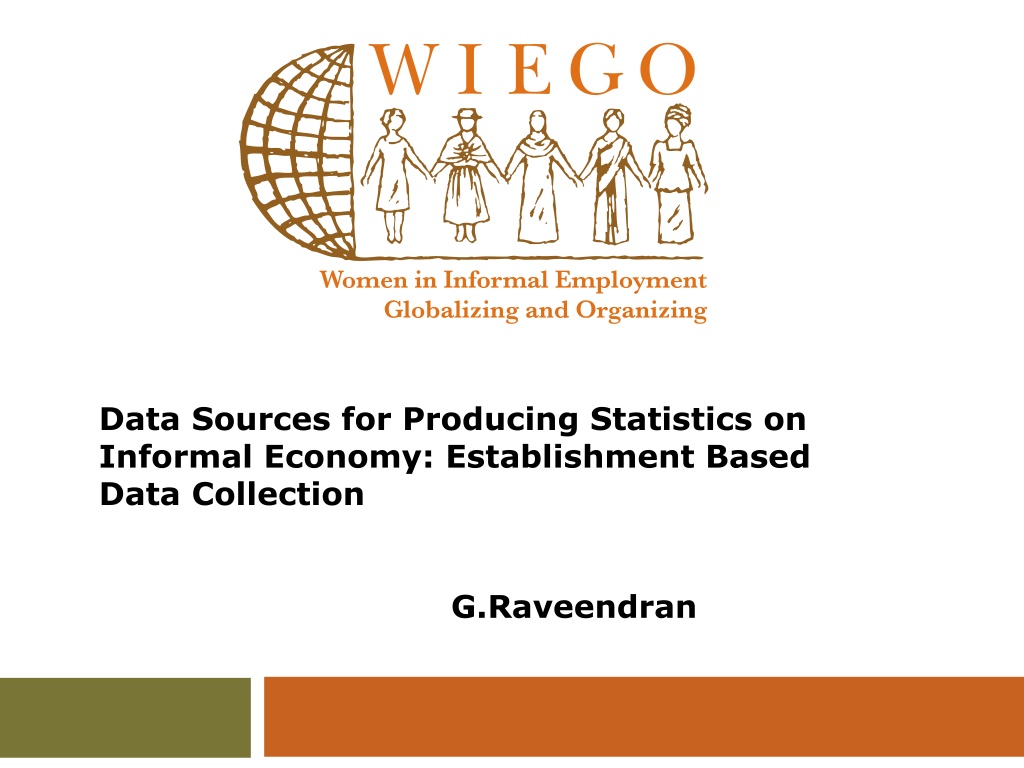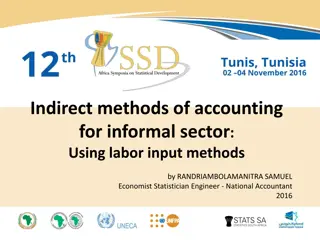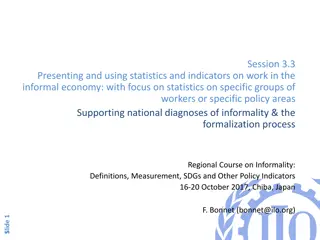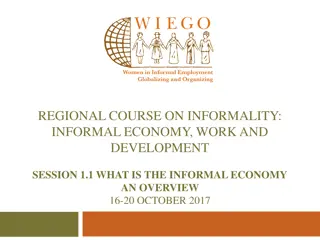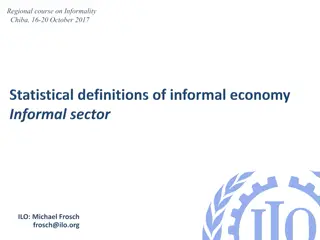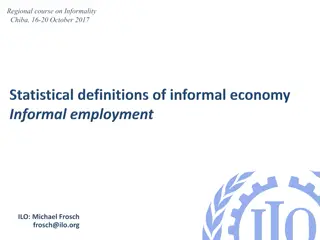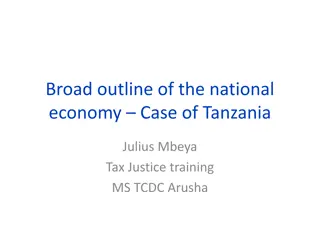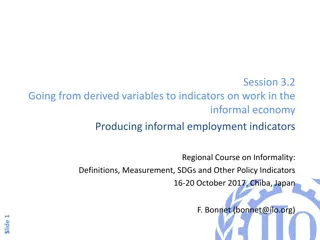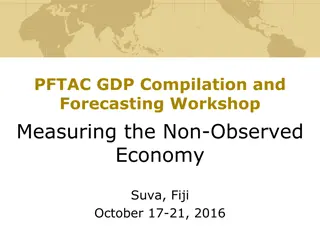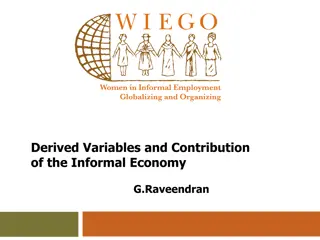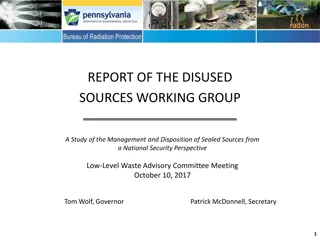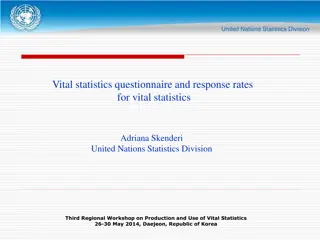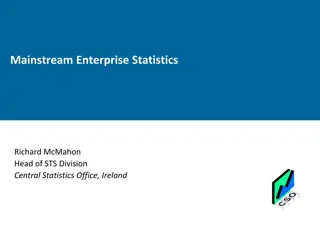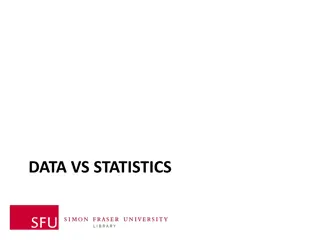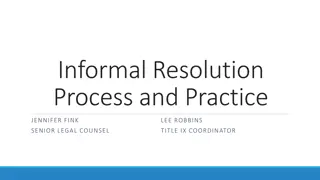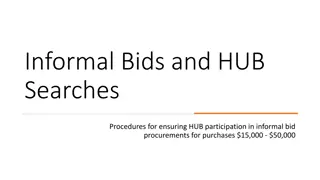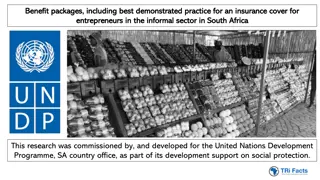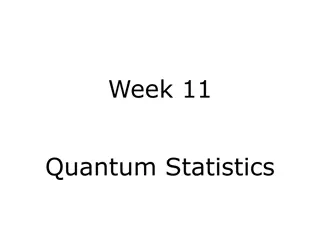Data Sources and Methodologies for Informal Economy Statistics
Exploring the importance of statistics in understanding the informal economy, this content discusses the need for reliable data sources in policy-making, evaluation, and investment decisions. It covers various data collection methods such as establishment-based surveys, administrative data, and enterprise surveys. Detailed insights into survey design elements and listing procedures for households and enterprises are also presented.
Download Presentation

Please find below an Image/Link to download the presentation.
The content on the website is provided AS IS for your information and personal use only. It may not be sold, licensed, or shared on other websites without obtaining consent from the author. Download presentation by click this link. If you encounter any issues during the download, it is possible that the publisher has removed the file from their server.
E N D
Presentation Transcript
Data Sources for Producing Statistics on Informal Economy: Establishment Based Data Collection G.Raveendran
Need for Statistics Necessary to provide the right perspective of the sector Essential Input for Policy Formulation and Strategy Development Monitoring and Evaluating the Impact of Policies and Programs Guiding Investment Decisions
Sources of Data Administrative Data Employment Returns Production Returns Tax Returns Census of Economic Units Sample Surveys Labour Force Surveys Enterprise Surveys
Enterprise Surveys List Based Surveys Area Based Surveys Independent Surveys Mixed Surveys
Elements of Survey Design Stratification Rural/Urban Density of Population/Enterprises Selection of Areas Probability Proportional to Size (PPS) Simple Random Sampling Cluster samplng Listing of Enterprises in the Selected Areas Stratification of Enterprises Industry Group Employment Size Selection of Enterprises
Listing of Households and Enterprises All households in the selected area need to be listed without omission and duplication List all the enterprises both visible and non-visible Data on classification variables needed for stratification of enterprises also need to be collected
Listing Procedure Listing is done structure by structure by following the house numbering system In case, house numbering system is not available, the listing is done in a serpentine order starting from the north-west corner, going down to south and then upwards Enterprises either operated within the premises of the household or without any fixed place are listed against each household
Data Elements on Listing of Enterprises House number Household serial number Household size Number of self-employed females and males in the household Number of distinct enterprises
Data Elements on listing of Enterprises - Contd Enterprise serial number Name of head of household/ enterprise Description of activity of enterprise Broad industry group code Mfg 1, Construction 2, Trade 3, H & R 4 T.S & G 5, Other services 6, M & Q 7, E,G & WS 8
Data Elements on listing of Enterprises -- Contd Number of total workers Number of hired workers Industry code Ownership code Proprietary male 1, Proprietary female 2 Partnership with members of same household 3 Partnership with members of other household 4 Co-operative society 5, Public sector 6 Limited company 7, Others 9 Eligibility Code Operated for at least 30 days (15 days for seasonal enterprises) during reference year 1 Operated for less than 30 days (15 days for seasonal enterprises) during reference year 2
Sample Selection Stratify the economic units by industry group Allocate sample size to each stratum Select the required number of enterprises from each stratum Sampling scheme may be SRS or systematic sampling
Detailed Survey Survey the selected units by using well designed modular survey instruments (schedules) Use separate blocks for collecting data on raw materials used, other inputs, receipt from sale of products and services, other receipts, employment and factor incomes Use industry specific input and output blocks for different industry groups Provide provision for collecting details of factor payments Provide summary block and provision for recording estimated value addition
Sample Survey Module Used in India Principal Operating Expenses Manufacturing Activity Item 301 302 303 304 305 Raw materials consumed Last month (Rs) Other raw materials Purchase value of the goods sold in the same condition as purchased Total 309
Other Operating Expenses Manufacturing Activity Item No: 371 372 373 Item Last month (Rs) Electricity charges Fuel and lubricant Raw materials for own construction Minor repair and maintenance of: Building Furniture & fixation 374 375 376 377 378 Machinery Transport equipment Other fixed assets
Other Operating Expenses Manufacturing Activity (Contd) Item No: 381 382 383 384 385 Item Last month (Rs) Rent payable on machinery and building Contract and commission expenses Travelling, freights & cartage expenses Communication expenses Purchase of consumable stores, packing materials, etc. Paper, printing & stationery Service charges for work done by other establishments License fee, cess charged by local bodies, etc. Other expenses 386 387 388 391
Principal Receipts - Manufacturing Activities Products & by products Item No 401 402 403 404 405 Item Last month (Rs) Other products/ by products Sale of goods sold in the same condition as purchased Total 409
Receipts - Manufacturing Activities Change of Stocks Item No 411 Item Last month (Rs) Opening stock of semi finished goods 412 Closing stock of semi-finished goods 413 Changes in stock of semi-finished goods
Receipts - Manufacturing Activities Other Receipts Item No 491 Item Last month (Rs) Receipts from services provided to others including commission charges Market value of own construction of building, furniture & fixtures Value of consumption of goods/ services produced Rent receivable on plant & machinery Funding/ donations received Other receipts Total 492 493 494 495 496 499
Employment Particulars of the Enterprise During the Reference Month Average number of workers Serial No Type of worker Full Time Part Time Female Male Female Male 1 Working owner 2 Hired worker 3 Other worker/helper Total 4
Factor Incomes of the Enterprise Serial No Item Monthly Value (Rs.) 1 Emoluments 2 Rent payable 3 Interest payable 4 Net surplus ( including home consumption) Total
THANK YOU WIEGO
